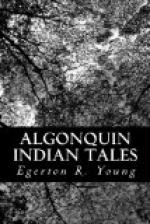Sagastao, who had laughed at the idea of the mosquitoes coming to a council, and of their having anything to complain of, said, “I would like to know what mosquitoes lived on in those good old days you speak about. Now they are after me lively enough.” And he slowly lifted up his hand, on the back of which a couple were rapidly filling themselves with his blood.
But Mary, who, Indian like, was wise and observant, only said, “Wait a minute or two and I will show you.” Then she quickly hurried back into a swampy place and soon returned with a thick juicy leaf, to the under side of which several mosquitoes were still clinging, with their bodies distended with its juice.
“There,” she said, as she carefully held the leaf sideways, “that is what most of the mosquitoes still live on. They attack our race in revenge for our being so cruel as to kill so many of the animals, large and small, but this, as you can easily see, is their natural food.”
This appeal to the eye quite silenced the children, who had considered the whole story as only an Indian legend to be amused with.
Mary, who had often been worsted by the sharp criticisms and inquiries with which they were apt to receive her pet Indian legends, was quite delighted at her apparent triumph, so she hastily sprang up, saying:
“It is time we were going home. Some other day I will tell you the story of how the medicines came.”
CHAPTER XII.
The Naming of the Baby—A Canoe Trip—The Legend of the Discovery of Medicine—How the Chipmunk Carried the Good News.
There was great excitement among a number of Indian men and women who had gathered on the shore in front of the mission one pleasant summer morning. Grave Indians, with Souwanas in their midst, were calmly discussing some object of interest, while Mary and a party of women, some of whom had their babies with them, were much more noisy, talking rapidly about something which was evidently a matter of exciting interest. Even Sagastao and Minnehaha were rushing in and out of the house and running from one group of Indians to the other, full of eager inquiries and pleasant anticipations. What could it all be about?
Let us ask the children, for such little people often know more than we are likely to give them credit for. Here comes Minnehaha, and we ask her the cause of such an early gathering of the Indians, and the reason why they are so unusually interested in some matter unknown to us.
[Illustration: “Their babies with them.”]
“Why, don’t you know?” the bright little girl promptly replies. “They have come to form a Naming Council, to give my little baby sister an Indian name. You see,” she added, “Sagastao and I were born among the Cree Indians, but baby was born here among the Saulteaux. Just think: the first little white baby born among them! And they want to give her a nice Saulteaux name. The reason why they are talking so much now, before they form the council, is that lots of them have pet names they want to give our baby, but of course she can only have one.”




